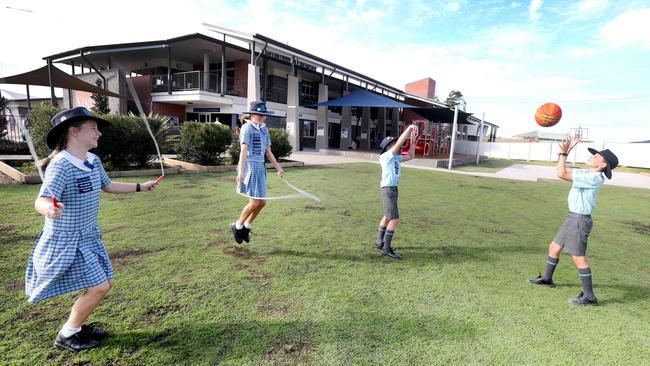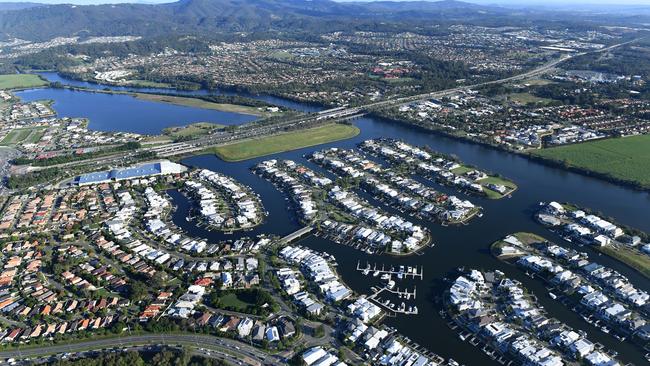One new school a year needed and more school buildings to keep up with Gold Coast growth
A LEADING demographer says the Gold Coast has to build schools fast to keep pace with population growth.

Gold Coast
Don't miss out on the headlines from Gold Coast. Followed categories will be added to My News.
A LEADING demographer says the Gold Coast will need to open up a new school each year to keep pace with local population growth.
Existing schools will also need to cater towards higher student numbers to absorb the annual influx of 2000-plus school-aged children.
MY FIRST YEAR: GOLD COAST PREP STUDENTS MEGA GALLERY
Social researcher and demographer Mark McCrindle of McCrindle Research told the Bulletin there had been a 25 per cent increase in student numbers over the past decade as schools were flooded with more than 20,000 students from 2006 to 2016.

“Have we added 25 per cent more schools or capacity?” he said.
“The answer is no. The number of new students is going up per annum, that’s why there’s some of these bottlenecks.”
According to a 2015 report by demographer Bernard Salt, the Coast will have a population of 1.2 million by 2050 and needs 35 new schools by then.
LNP MP David Crisafulli said that any new schools planned needed to be carefully thought out and delivered “ahead of the game.”
“It’s in catch up mode,” he said.
“Let’s deliver up front putting in new classrooms and new schools in the northern corridor.”

But a spokeswoman for the Minister of Education Grace Grace said the Labor government were continuing to deliver record investments in education.
“We are delivering a statewide Infrastructure Investment Program valued at more than $778 million in 2017-18,” she said.
“We have a proven track record for delivering for Gold Coast students and schools. One of four new state schools to open in Queensland this year was the $40 million Picnic Creek State School, located at Coomera East.
“Construction is also underway on a new multi-purpose hall at Pimpama State School, which is due to be completed later this year.”

An earlier 2014 Quinn report found at least eight schools were needed to cope with the increased populations at Pimpama, Helensvale and Coomera by 2031.
In Coomera alone, there have been more than 5000 students filter into local schools in the past three years.
Mr McCrindle said as the Gold Coast was the sixth largest city in Australia, there would be ongoing growth issues in schools for the foreseeable future.
Many existing schools would also need to build extra classrooms to boost their capacity to educate children, while new schools would need to plan ahead for extra buildings.
“(But) ... it can only happen for so long,” he said.
“Parents are looking for the right subjects, for the green space, you can’t have too many students for the space.

“I think there’s been a ... catch up and the capacity has been absorbed across schools, but now there’s this growth movement it won’t take long for them to hit capacity.”
Even a new Catholic school set to open next year, St Joseph’s College Coomera, with the capacity to accommodate up to 1800 students over six years, would not be enough to cope with the predicted numbers.
But Mr McCrindle said the new school was on the right path, saying the independent sector for schooling was in great demand.

“Over the last two decades, parents have been looking for independent schools,” he said.
“To have a non-government school and of that size, is part (of the solution). Across Australia, 40 per cent of high school students go to non-government schools. The biggest sector, outside of the government sector, is the Catholic sector.”
Mr McCrindle said one in five locals defined themself as Catholic and the school opening in the area was “ticking that box”.

Another factor the Gold Coast needed to look into was university capacity, he said.
He said now that nine in 10 students were finishing their schooling, compared to a decade ago when it was just six in 10, a new university was necessary.
“There’s 35,000 students in secondary school,” he said.
“There’s more than 40,000 in tertiary education. As a big proportion of high schoolers finish school, even larger numbers will go with tertiary study.
“Education is quite a theme and making sure we have the quality education facilities to cater for this generation is key.”


